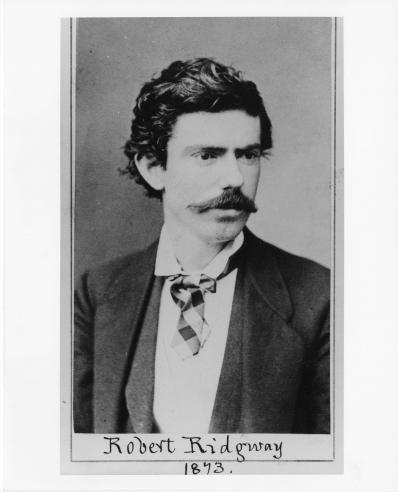I’m as big a fan of Robert Ridgway as anybody, and I couldn’t be more delighted that at long last, decades after we all learned to say “buff-collared nightjar,” the man is once again commemorated in the English name of a US bird.
The Smithsonian ornithologist was just 24 years old when he described this bird — not, mark well, as a new species but rather as a new race, obsoletus, of the king rail.The type specimen, A 6444 in the collections of the National Museum of Natural History, was sent east from San Francisco, California, where it had been obtained in March 1857 by George Suckley. Obtained, but not exactly collected: as Suckley reported in 1859,
The king rail [= today’s Ridgway’s rail] is very common in the San Francisco market…. A fine specimen was presented to me in San Francisco by F. Gruber, an excellent practical taxidermist of that city.
Edward William Nelson fills us in:
F[erdinand] Gruber was a German taxidermist, in San Francisco, who was well known in the ’70’s and ’80’s of the [nineteenth] century. He had a shop for a long time on California Street… a small gruff man, rather repellant at first contact but … under the crust was a most friendly person to any young naturalist interested in birds.
Crusty or not, Gruber would be named the first curator of ornithology at the California Academy of Sciences. His place in ornithological history was assured in 1870, when Robert Ridgway (who else?) described a new species of hawk from California, which he named Onychotes gruberi for that
zealous naturalist and accomplished taxidermist of San Francisco, having added much to our knowledge of the birds of California, through the frequent contribution of valuable specimens.
The honor was hardly diminished 15 years later when Ridgway re-examined the specimen and determined that it was, in fact, a Hawaiian hawk that had made its way — no doubt already a skin — into Gruber’s store.
George Suckley, too, was the beneficiary of Ridgway’s gratitude when it came time to name a small sooty falcon from Washington Territory. Ridgway gave his new subspecies from “the northwest coast region of heavy rains and dense forests” the scientific name suckleyi. We knew it for a while as Suckley’s pigeon hawk, but now it is, more blandly, just the black merlin.
I’m glad that Ridgway has his rail. But we mustn’t forget, it seems to me, that he got it from Suckley, who got it from Gruber, who got it from an unknown rail hunter in the long-ago market stalls of San Francisco.
Even bird skins have their stories.


